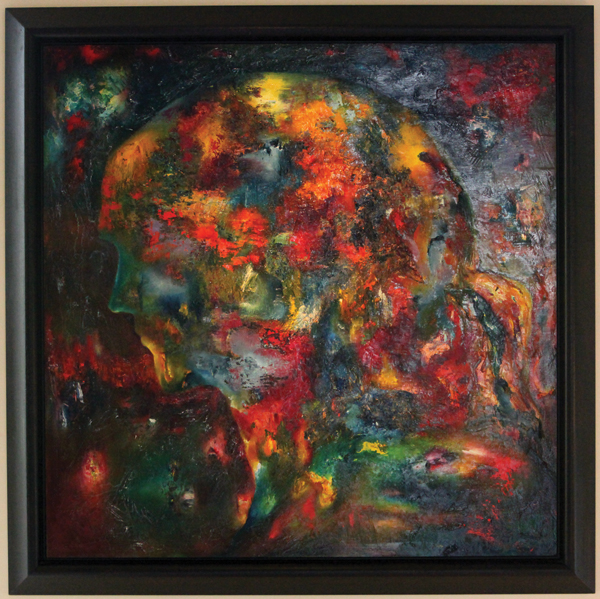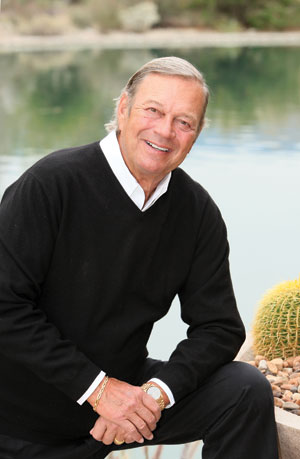 |
| Photo by: RENE MACURA |
It’s an unusually overcast afternoon in the desert, as Don Ohlmeyer hops in his personal electric golf cart and putters around the streets of The Reserve, an exclusive golf community in Indian Wells, Calif.
Dressed casually in black slacks, a V-neck sweater and loafers with no socks, Ohlmeyer appears relaxed on this weekday in early February. He played golf earlier in the day — shooting a 78 on the local course — and now is giving a tour of the community where he’s lived part time for the past nine years.
At seemingly every turn, he runs into people he knows. He stops to chat with each of them, sharing light, good-natured banter. One of his neighbors hosted a flapper party the night before that Ohlmeyer and his wife, Linda, attended. Stories from that party were a big topic and the cause of many laughs.
A media titan known for his hard-charging personality and take-no-prisoners approach, Ohlmeyer has taken to retirement with the same gusto that he approached his career, where he is one of the most accomplished executives in the history of American television.
He grew up in the business as one of Roone Arledge’s disciples at ABC Sports. He eventually moved over as executive producer of NBC Sports, ventured out on his own by setting up his own company, and he wound up heading up NBC Entertainment’s West Coast office.
Ohlmeyer has a well-earned reputation as a workaholic, consumed by whatever task is at hand. From the late 1960s through the 1990s, he used that all-consuming work style to become one of the most influential media executives in the United States.
But since leaving “Monday Night Football” in 2000, he has kept a relatively low public profile. He consults for at least one television network, he teaches a course in directing at Pepperdine University, and he produces paintings that regularly sell for more than $10,000.
Seeing how relaxed Ohlmeyer, 67, is today, it’s difficult to picture how nonstop, forceful and brash he once was.
“I really got tired of fighting the wars,” he said. “There’s a lot of pain involved in these things. A lot of personal pain. When you’re young and brash, you don’t really give a shit. As you get older, God, you get tired of fighting. I got tired of fighting with people. I got tired of yelling and screaming and stamping my feet.”
But it was those wars — or, to be more precise, Ohlmeyer’s single-minded pursuit in battling them — that his admirers remember most fondly and that have come to define Ohlmeyer’s career.
Few media executives can match Ohlmeyer’s accomplishments. He has produced the biggest events on TV. He’s created shows like “The Skins Game” and “The Superstars” that have entered the national conscience. You’d be hard-pressed to find an executive who has done more to change the way Americans watch television than Ohlmeyer.
But this isn’t a story about what he’s done since starting in the business in 1967. Rather, it’s a story about how he’s done it and the “wars” he’s had to fight to get what he wants.
“The great thing about Don is that Don would win almost all of the wars,” said “Sunday Night Football” announcer Al Michaels, who has known Ohlmeyer since 1975. “When you were on Don’s team, you didn’t have to fight them. He’d fight them, and he’d win almost all of them.”
Ohlmeyer spent a career getting people to bend to his will: his bosses and his direct reports, people in the production truck, and talent in front of the camera.
Memories of Munich tragedy still vivid for Ohlmeyer
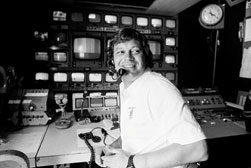 |
Ohlmeyer lists Emmy-winning “Triumph and Tragedy” as his proudest accomplishment.
Photo by: AP IMAGES
|
When asked what accomplishment makes him proudest, Don Ohlmeyer has an immediate answer.
“It’s a show I did called ‘Triumph and Tragedy,’” he said.
The reference is to part of a preview show for the 1976 Olympics, which included a 35-minute recap of the Munich Olympics, when terrorists murdered 11 Israeli athletes and coaches during the Games.
The show won an Emmy Award and still elicits strong emotions in Ohlmeyer. Though the massacre happened nearly 40 years ago, tears freely fall from Ohlmeyer’s eyes and his voice cracks repeatedly when he talks about that day in Munich.
“That was a life-changing event for me,” he said. “I was in the studio all day long watching that.”
Speaking slowly to try to catch his emotions, Ohlmeyer spoke of the tension in the studio that day. Two hours before Jim McKay famously broadcast the news to America that “They’re all gone,” ABC Sports executives knew all of the hostages had been killed.
“But Roone [Arledge, ABC Sports’ executive producer] had instilled in us from the beginning of the day that one of the things that we needed to be sensitive to was that David Berger’s parents were sitting in Shaker Heights, Ohio, watching the telecast. And their son was one of the hostages,” Ohlmeyer said. “We were their only tie to that. Whatever we reported had to be accurate.”
As soon as the news was broadcast, Ohlmeyer told Arledge that he couldn’t stay in the studio because he was too physically and emotionally exhausted. He went with his friend, sportswriter Pete Axthelm, to their hotel bar and stayed up until 4 a.m. drinking and pondering life.
“Up until then, I was an incredible optimist about life,” Ohlmeyer said. “After that night, I became a much more cynical person. Maybe much more realistic, but at least much more cynical.”
Days before “Triumph and Tragedy” was scheduled to run during the 1976 Games in Montreal, Ohlmeyer received a call from a woman on Israel’s 1976 team. She had heard about the show and asked whether some athletes from Israel’s team could come and see it.
Ohlmeyer arranged to have them come to the ABC studio the next day at 7 a.m., the only time a tape machine was free.
“Here it was, 7:40 in the morning in Montreal, Canada, in 1976, and here are nine Israelis, a videotape operator and me standing in a tape cubicle, with tears rolling down our cheeks,” Ohlmeyer said. “When you ask me, what am I most proud of? It’s having been able to do something that could touch people emotionally like that.”
— John Ourand
While stories of his volatile temper are legendary (he routinely would blow up in the production truck, in his office, or wherever he was working), he also would use more subtle approaches when needed. Take his approach to dealing with “Monday Night Football” announcer Howard Cosell, for example. He wouldn’t harp on every transgression. Rather, he would wait until Cosell really crossed the line before bringing down his hammer.
“What I would have to do with Howard is I would have to wait,” he said. “Sometimes it would take three or four weeks for him to do something that was so outrageous even he knew it was over the line. Then I would just beat the living shit out of him, and he would be fine for two months.”
For Ohlmeyer, the battles started with his first job in broadcasting, when he was hired straight out of Notre Dame to become a production assistant at ABC Sports, and continued throughout his career. Even in retirement, there have been battles for Ohlmeyer. He referenced a battle he fought during his teaching gig at Pepperdine, when he wanted to make a change to the curriculum. That was one he didn’t win.
“It took me a long time to learn that it’s never a waste of time to try and make things perfect,” he said. “But sometimes, the scars aren’t worth the battle.”
Ohlmeyer’s longtime friend Geoff Mason, a fellow member of the Sports Broadcasting Hall of Fame, believes it’s Ohlmeyer’s deep-seated need for perfection that underscores the battles he fought during his career.
“No one ever gave as much of himself or contributed more to the creative energy of our business than Don,” Mason said. “He’s one of the smartest, hardest-working people I’ve ever known in my life.”
Bob Basche, who worked with Ohlmeyer at NBC Sports in the late 1970s, offered a glimpse of how often these disputes would pop up and how Ohlmeyer wouldn’t hesitate to battle his bosses, his production staff or rights holders to pursue something he thought was right.
When Ohlmeyer joined NBC in 1977, he hated the fact that Wimbledon’s final was aired on tape delay, six hours after the actual start of the match. In 1979, he finally convinced NBC to air the final live, starting at 9 a.m.
One battle was won.
But another battle immediately started when Ohlmeyer wanted to start the broadcast at 9 a.m. with a shot of the players — Bjorn Borg and the American Roscoe Tanner — walking onto the court. The All-England Club pushed back, saying they would not change tradition that mandated the first serve occurred at 9 a.m.
“Don went absolutely ballistic,” Basche remembers.
Ohlmeyer enlisted Tanner’s agent, Donald Dell, to convince his client to stall in the locker room long enough to allow NBC to carry the shot of Borg and him walking onto the court live. Tanner complied.
Another battle won.
Not everyone appreciated Ohlmeyer’s forceful approach, though. There are many who caught the brunt of Ohlmeyer’s ire who still harbor bad memories, but none was willing to speak on the record. Ohlmeyer admits to being a “tough boss to work for.”
“I was fair,” he said, “but I was tough.”
Basche and others say he has many more supporters than detractors. “While he cared for people, he demanded they were as good as he was,” Basche said.
Ohlmeyer’s supporters are effusive in their praise. They consistently describe him as one of the giants in sports broadcasting history and suggest that he never truly has received his due.
“Don’s on Mount Rushmore, right alongside Roone Arledge and David Hill,” said the NFL’s top media executive, Steve Bornstein, who worked with Ohlmeyer during the early days of ESPN. “I don’t use the term ‘genius’ too much, but Don would be in that category.”
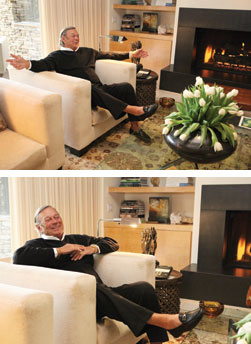 |
Ohlmeyer’s retirement in Indian Wells, Calif., is filled with the same enthusiasm as was his career, along with teaching, golf and working in his art studio.
Photos by: RENE MACURA
|
A winner of at least 16 Emmy awards, Ohlmeyer’s stature as a sports TV producer is not in question.
“He’s had a creative energy that, perhaps, has been more impactful than Arledge,” Mason said. “The shows that Don has sat in the director’s chair for over the decades — no one has even come close to living the life he did.”
But Ohlmeyer’s influence extends far beyond the production truck. He also has a résumé of successful business deals that makes him one of the most accomplished sports business executives of all time.
“Many people know his name but don’t really understand his influence,” said best-selling author Jim Miller, who got to know Ohlmeyer while writing books on “Saturday Night Live” and ESPN.
Ohlmeyer was an early believer in cable television, seeing its power decades before other broadcasting executives warmed to it. Through various business dealings, he made more money from ESPN than any other single executive, Bornstein said in Miller’s book on the network.
In 1984, his Ohlmeyer Communications Co. paid $60 million for a 20 percent stake in ESPN, giving Ohlmeyer a seat on the network’s board. Nine years later, Ohlmeyer sold the sports programming and sales divisions of his company to ESPN for more than $24 million, according to the book.
“I’m kind of like Wyatt Earp: I’m good to come into town and clean it up. Then, when it’s cleaned up, you should probably leave,” Ohlmeyer said. “I’m not good at caretaking. I’m good when there’s a challenge. I’m good when there’s a war to fight.”
In fact, it was the growth potential of cable television in the 1980s, coupled with the U.S. Olympic boycott in 1980, that convinced Ohlmeyer to leave NBC to set up his own company.
“I had really gone to NBC to do the Olympics from Moscow. And then that peanut farmer …” Ohlmeyer said, his voice drifting off when referencing former President Jimmy Carter’s decision to boycott the 1980 Summer Games in Moscow to protest Russia’s invasion of Afghanistan. “That was combined with the fact that I really saw that the world was going in a different place.”
While Ohlmeyer relished the corporate wars — and was extraordinarily successful in fighting them — they left scars on both him and his family, he says now.
“The accomplishments really were quite unbelievably satisfying,” he said. “But it screwed up my marriage. I was not as good a father as I should have been because I wasn’t around as much as I should have been. There were times that I didn’t really like the person that I was becoming or the person I became.”
In the mid-1990s, Ohlmeyer’s family and friends were growing increasingly worried about him. At the time, he was overseeing NBC’s West Coast office and had helped steer the network from third place to first.
But the self-described Wyatt Earp could not stand caretaking that business. He was drinking heavily. His family and friends were concerned for his health.
In late 1996, Mason, who was on the board of the Betty Ford Institute, and then-NBC President and CEO Bob Wright organized an intervention with Ohlmeyer’s sons. They thought it was the only way to convince the hard-charging executive to seek help. It worked.
“I’d been working on that for two or three years,” Mason said. “Thank God we did it. He didn’t have a lot more in the tank.”
In December 1996, a close group of family and friends sat Ohlmeyer down and read letters imploring him to go to rehab. When the last person spoke, Ohlmeyer took a long drag from an ever-present Marlboro and simply said, “Let’s go.”
“The funny thing was that I had done this series for NBC called ‘Lifestories’ and I had directed an episode about an intervention,” Ohlmeyer said. “So when I walked into the intervention that morning, I knew exactly what was going on.”
After about a month at Betty Ford, Ohlmeyer exited as a changed man. He retired from NBC a little more than two years later.
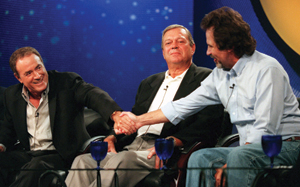 |
Ohlmeyer got people talking in 2000 when he added comedian Dennis Miller (right) to the “Monday Night Football” booth with Al Michaels (left).
Photo by: AP IMAGES
|
ESPN coaxed Ohlmeyer out of retirement to once again work on “Monday Night Football,” which had been flagging in the ratings. Ohlmeyer was excited for the challenge, and the opportunity saw him make one of his most controversial (and talked about) programming decisions. Faced with revitalizing a tired show, he tabbed comedian Dennis Miller to be the third voice in the booth with Michaels and Dan Fouts. Critics slammed him for being out of touch, but Ohlmeyer still believes in the move.
“Dennis was a good choice because he accomplished [what we wanted]: People started talking about ‘Monday Night Football’ again,” Ohlmeyer said. “Miller was on the cover of Sports Illustrated. People started talking about it. The biggest problem was the ratings had dropped substantially in young males. And the rating for young males went up like 10 percent that season.”
Michaels, who did play-by-play that season, supported the choice, even if it lasted only two years. “To me, it was a stroke of genius,” he said. “He took a show that was flagging a little bit, at least in terms of public perception, and made it relevant again.”
But overall, those close to him saw a different type of executive. Ohlmeyer lasted one season.
“You just come out a changed person,” Ohlmeyer said of his stint in rehab. “I was never really the same. I certainly didn’t have the same drive.”
Michaels said Ohlmeyer threw himself into that final season, but as the year wore on, he started to recognize that Ohlmeyer would not be a long-term fix for the series.
“I thought he’d go one more year. I was pretty sure he would,” Michaels said. “I think he realized that he did what he had to do. And it’s all-consuming.”
Now, Ohlmeyer is all-consumed with retirement. Finishing his tour of The Reserve, Ohlmeyer pulls his golf cart into his garage and starts to walk up the front walk.
Before going inside, he wanders into his art studio. It’s a small room filled with his paintings. Most are finished; some are unfinished. “It’s like his control room now,” said Jim Miller, who has seen the studio.
Eventually, he walks inside his house and goes to the den. Amid a bevy of Emmy statues and an MTV Spaceman (he created the MTV Awards show, too) are three flat-screen TVs. It’s the only way he knows how to watch TV.
“If I don’t have multiple screens to watch, I’m kind of bored,” he said. “I guess the thing I’d have to say is that my life has really been damn interesting. There’s things I’d like to have done differently and moments that I wished I had handled differently. But, God, it’s been damn interesting.”
Ohlmeyer's artwork provides a creative outlet
Don Ohlmeyer asked a photographer who was taking his picture inside his Indian Wells, Calif., home to describe what she saw in one of his paintings. Hanging on a wall next to a door that led to the backyard, it was a painting filled with rich colors. To a casual observer, the painting’s subject could have been almost anything.
“Well, I definitely see a woman,” the guest responded, focusing on the faintest outline of a woman’s profile.
“You’re right. That’s my wife,” Ohlmeyer said. “You’re the first one that’s ever looked at that painting and saw that. Normally, people say, ‘I see an explosion’ or ‘I see a volcano.’”
Ohlmeyer has remained busy in his retirement. He plays endless rounds of golf (he only plays on days that end in “y,” he joked) and he teaches a class at Pepperdine University, which is about two to three hours from his home.
But his most surprising and successful pursuit has been as a painter. Ohlmeyer has become such a prolific painter that he’s held art shows displaying his work, sold several for more than $10,000 and has started taking commissions.
“I love doing it,” he said. “I never even doodled as a kid. When I started selling paintings, I felt embarrassed.”
Around 2000, Ohlmeyer decided that he wanted to learn more about art. He and his wife, Linda, took classes at UCLA in western art and modern art. Eventually, he hired an artist — “to teach me how to draw,” he said — and a few years later, he started producing artwork that he would place in his homes in Indian Wells and Malibu.
“I did this series of paintings in black, which sounds very boring, but they were all done with texture and subtle shadings of black. They were quite effective,” he said. “I had a couple hanging in my house in Malibu. The decorator who did our house in Malibu called Linda and asked, ‘Would Don ever sell one of his paintings?’”
It was 2004, and the decorator was working on a house for an actor. (Ohlmeyer would not say who but did say, “You would know him.”) He thought one of the black paintings would fit over a fireplace in the actor’s home.
Ohlmeyer said no.
He recalls telling Linda: “I’m doing this for fun. I didn’t do them to sell them. They’re my paintings. I’m not selling them.”
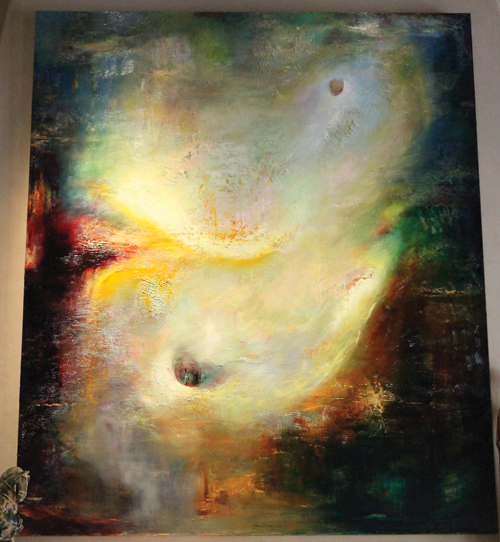 |
Ohlmeyer and his wife took classes in modern and western art from UCLA. He has sold several paintings for more than $10,000.
Photos by: RENE MACURA
|
The decorator was persistent. He borrowed one of the paintings to see how it would look. The next day, he tried, again, to convince the Ohlmeyers to sell it, calling Linda. She asked the decorator how much the actor had budgeted for a piece of art to go over the fireplace. When the decorator gave her a figure, Linda told the decorator that if the actor agreed to spend $1 over that, she’d convince Ohlmeyer to sell it.
“So I come home and she said, ‘You’ve sold your first painting,’” Ohlmeyer recalled. “She let me rant for a while. Then she said, ‘They paid blank.’ I said, ‘You’re f---ing kidding me.’ She said, ‘It was $1 more than they had in their budget for the spot over the fireplace.” I said, ‘Honey, that’s pretty cool.’”
With a small studio attached to his Indian Wells house, Ohlmeyer said he tries to paint as often as he can. He hasn’t painted as much in the past year “because I started painting some really dark stuff that made me more depressed,” he said. He’s getting back into it now.
“It is cathartic as long as it’s not reminding you of some depression or something like that,” he said.
— John Ourand






